If you have only one day in Prague I suggest you start at the Prague castle and work your way down the cobbled streets, walk over the Charles Bridge and finish your walk in the centre at Vaclavske Namesti or Old Town Square.
This is pretty much what I do every time I come to Prague after a long time or if I just want to have a good walk. It combines my favourite places, coffee houses, shops and views of Prague.
While it’s not exactly a non-touristy view of Prague, if you follow my suggested walk, you’ll find that you’ll meet fewer people than if you start in the centre of Prague.
Apart from the tram ticket to get you to the top of the hill to start the walk, you’ll not need to buy any more tickets (besides there is really no good public transport that would connect or take you part of the walk – it’s all within the inner town). The tram network circles around the Old Town Square, so you’ll always need to walk to get to the main tourist atractions.
Make sure you pack good shoes for your Prague visit, as you’ll be on your feet all day and Prague streets are full of cobblestones. Depending on which month you want to visit Prague, you’ll also need to pack a sensible clothes for the type of weather you’ll encounter.
EVERYTHING YOU NEED TO KNOW BEFORE YOU TRAVEL
- Prague location & position in Europe and the Czech Republic >>
- Getting from the Vaclav Havel airport to the centre of Prague >>
- Using English in Prague >>
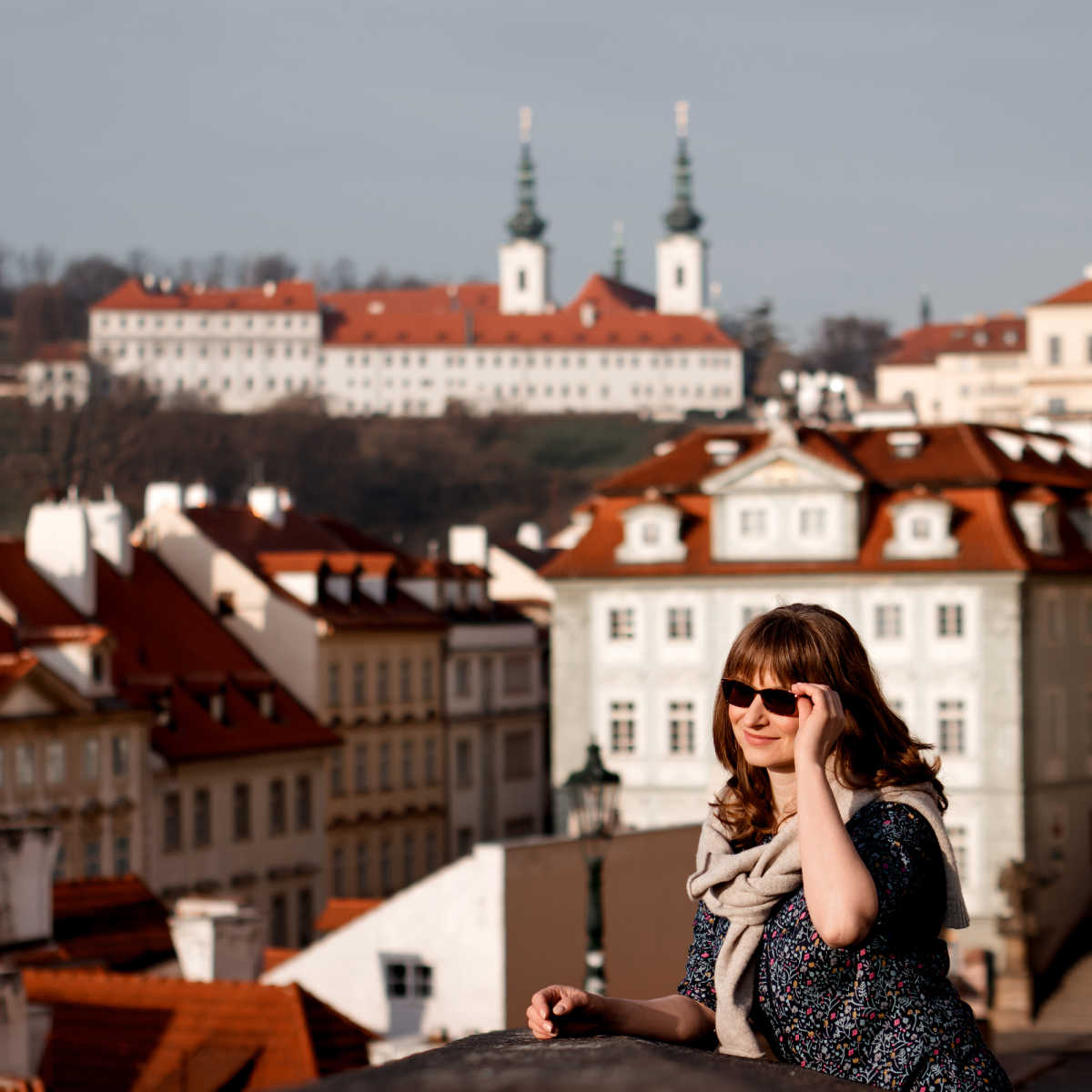
Is one day in Prague enough?
One day is definitely not enough to see everything in Prague, but if one day is all you have, then my guide will help you to make the most of your day.
Because this Prague itinerary is for one day only, I’m going to leave out any suggestions of going inside museums, castle or other attractions. Unless it’s raining or you have a specific interest in a particular museum, there is really not enough time to see everything. And besides, the view of Prague, whilst walking around is truly spectacular in itself.
I’ll mention what you can see on the way and you can either decide to visit later or you can easily split this 24 hr Prague itinerary into 2-3 days.
My one day Prague itinerary is also low budget. That’s not because I’d planned it this way, but since the best way to see the town is to walk, explore the town away from the crowds and eat like a local, you are not going to need to spend a lot of money.
I’ve also included optional detours or places to visit on the route, if you fancy to stop for a while or you want to skip a particular area.
MORE PRACTICAL TRAVEL TIPS
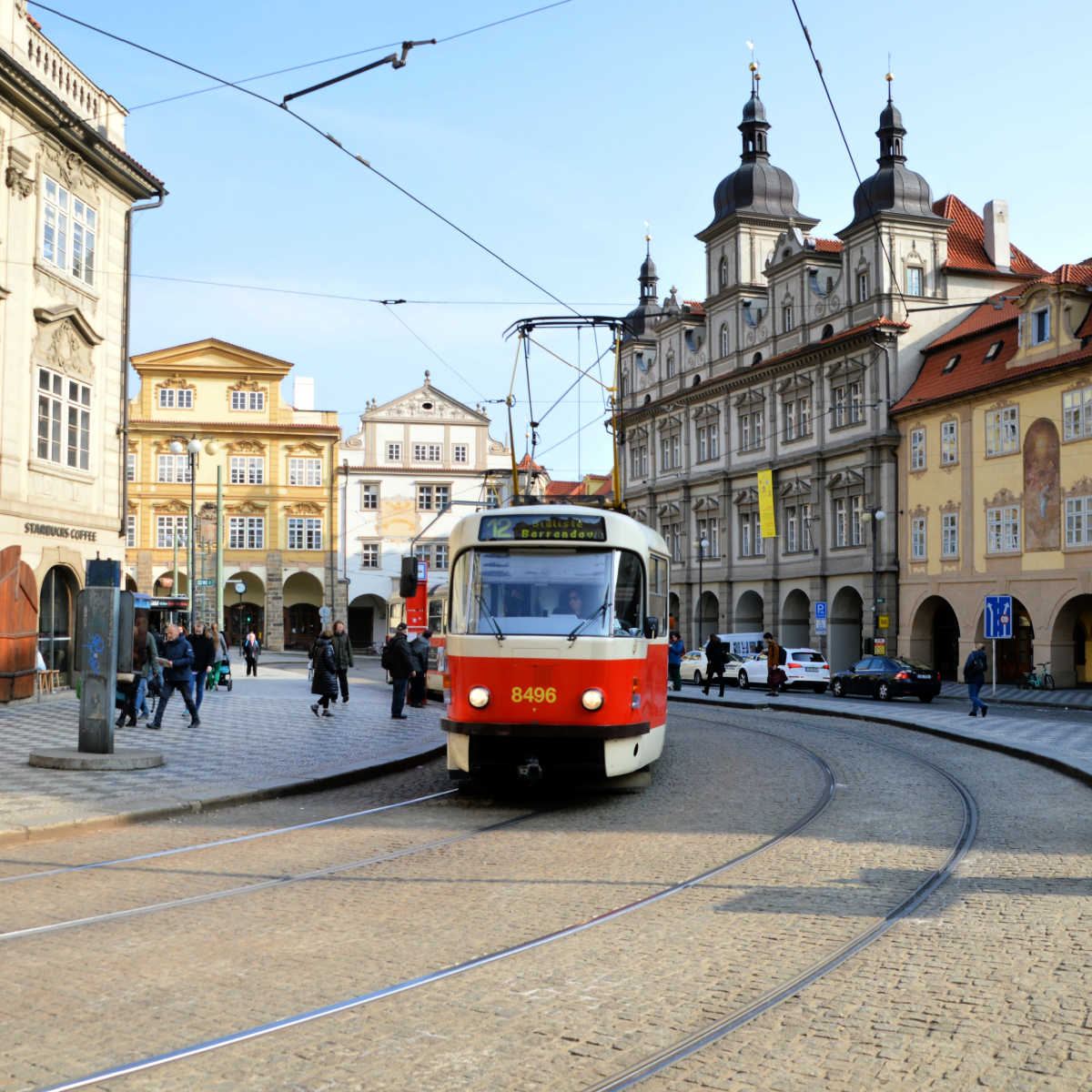
One day in Prague itinerary – area by area
Start at Staromestska Metro or tram stop and take the ride up the Castle Hill
We will start with a tram ride up to the top of the Prague Castle Hill, but unlike most people don’t get off at the official Prague Castle tram stop, but carry on a couple more to reach the very top of the castle hill a stop called Pohorelec. A tram number 22 will get you there from the centre or Staromestska Underground – Metro Station.
From Staromestska, the tram will go up the hill first and then turn around and you’ll get a great view of Prague, the green gardens around Prague Castle and the palaces behind the Prague Castle.
You’ll also pass Ana’s Summer Pavilion (Anensky Pavilion) and carry on pass the official Prague Castle Stop. The one you’ll want to get off is called ‘Pohorelec’ and it’s 2nd stop after the Prague Castle Stop.

New world quarter – Novy Svet
You will find the streets of New World tucked away behind the Loretta Church square. This is a quarter of Prague that’s like a forgotten town from the last century.
Tiny houses, cobbled streets, old-fashioned coffee houses and even a country cottage. Once you walk over to the Prague Castle complex itself, you’ll realise even more how very special this area is.
Explore Prague Castle grounds
The Prague Castle complex is open from 6 am, which means you can start your 24 hours Prague day as early as you want to. The beauty is that if you go there sufficiently early, you’ll miss most of the tourists and you’ll have the castle nearly all for yourself.
I’d suggest walking around with a good Prague guidebook to learn more about the castle. Alternatively, you can just enjoy walking around and taking it all in. Don’t miss the large Cathedral (and go behind rather than in front of it to find out another hidden corner of Prague Castle).
The entrace to the Prague castle grounds is completely free and you can also explore most of the top level castle gardens and streets for free.
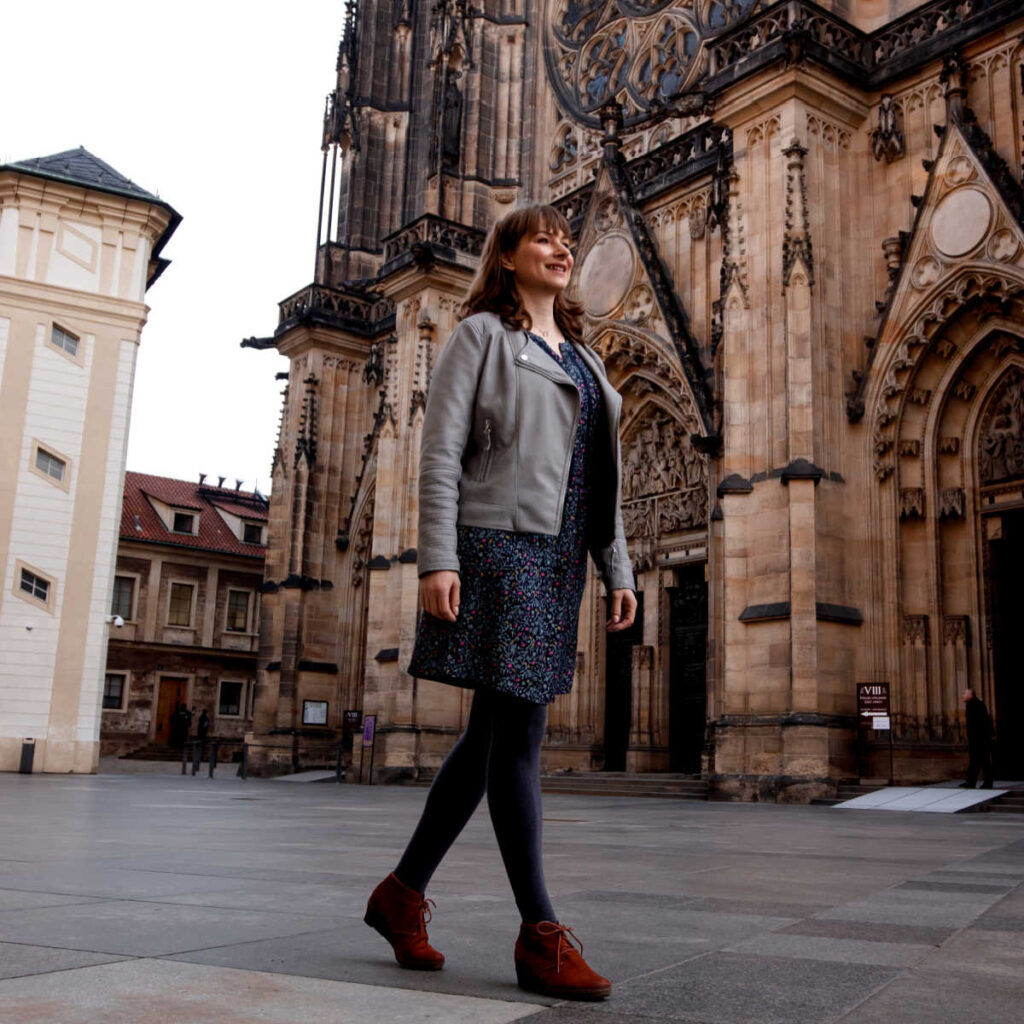
Coffee at Lobcowicz Palace
The only private palace within the Prague Castle Complex is the Lobcowicz Palace (Lobkowicky Palac). It has a museum and a gallery, but more importantly, it has a coffee house with amazing views of Prague below Castle hill. Depending on how much time you have at least have a look around or stay for a coffee and a cake.
Return back to the main entrance of the Prague Castle, where you can find more great views of Prague, the Monastery, the Petrin Hill Park area and, of course the historic Petrin Tower. This is a great opportunity for a photo, especially if you get there early in the day.

Nerudova Street & quirky shops
Go back up to the main entrance to the castle and walk down the cobbled streets of Nerudova Street.
As you walk down, you’ll pass a lot of tourist shops, which are actually pretty interesting. You’ll first see a handmade chocolate shop called Prazska Cokolada with really good chocolate bean to bars infused with various flavours. Although the chocolate might be a bit pricier than normal chocolate, I think it’s nice to try something different and locally made too.
There are also little shops with wooden marionettes, local crafts and a gingerbread shop, which is definitely worth visiting (if only for the amazing smell). Unlike ‘trdelnik’ which is definitely not a traditional Czech sweet, gingerbread is.
The traditional gingerbread is firm and decorated with white icing with intricate décor. It’s delicious to eat and also makes a great present to take home (it’s hard, so it travels well).
If you still do fancy trying Prague famous trdelnik, then the Cafe U Kajetana is one of the best places where they serve homemade trdelnik with lots of different flavours. My favourite one is with plum jam and they also have vegan version too.
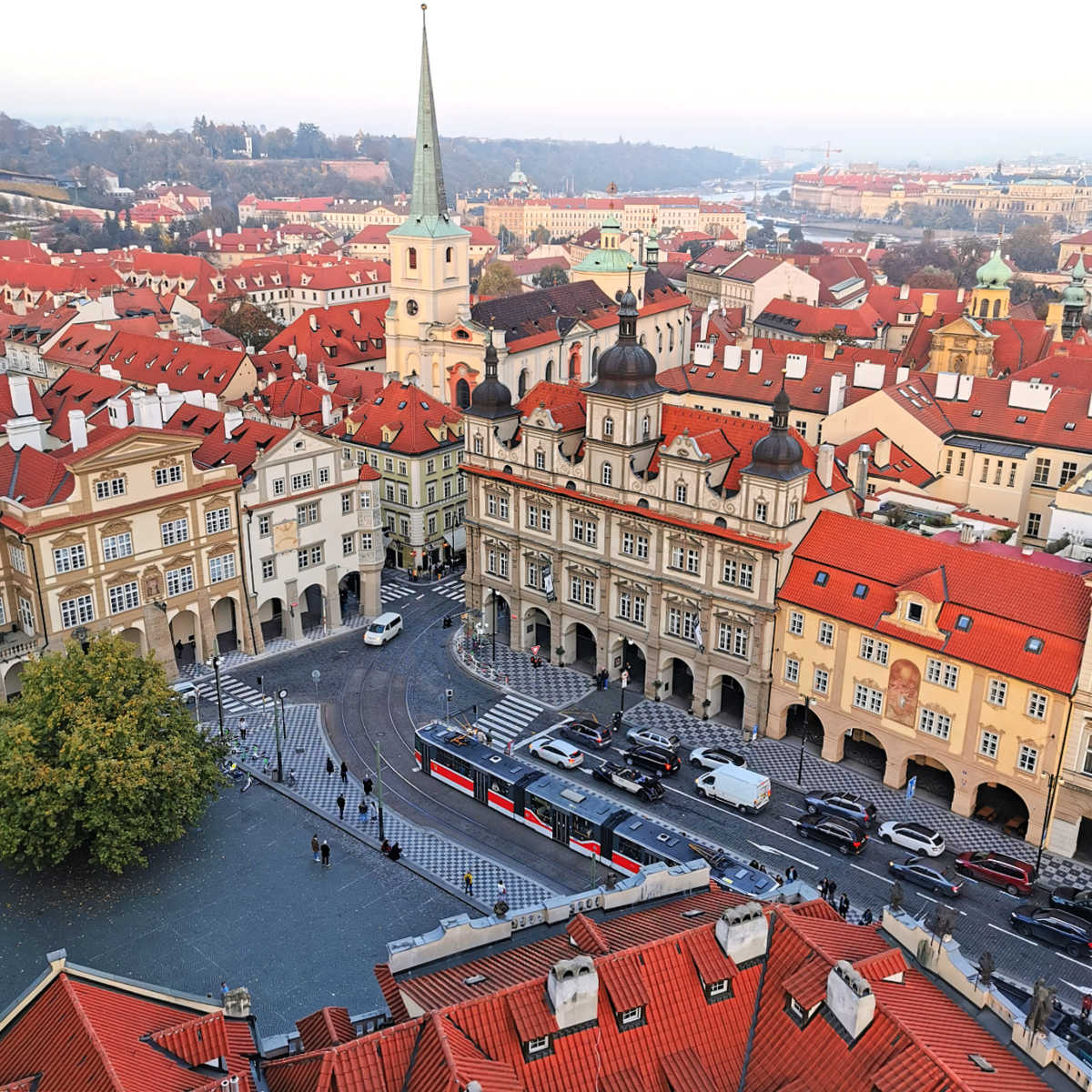
There are also few traditional pubs, which have food, beer and other drinks, so if you are feeling peckish you can make a stop. Bear in mind that having food in a restaurant might take a bit of time, which cuts into our day.
I prefer to just walk down the Nerudova Ulice and grab a Fried Cheese in a Bun (Smazeny syr) or Hot Dog (Parek v rohliku).
There is a little stall with hot food on the corner of Nerudova Ulice and Malostranske Square as you are coming down the hill. It’s been there ever since I remember from my student days and it still has reasonably priced hot food and drinks, that you can just buy and carry on walking.
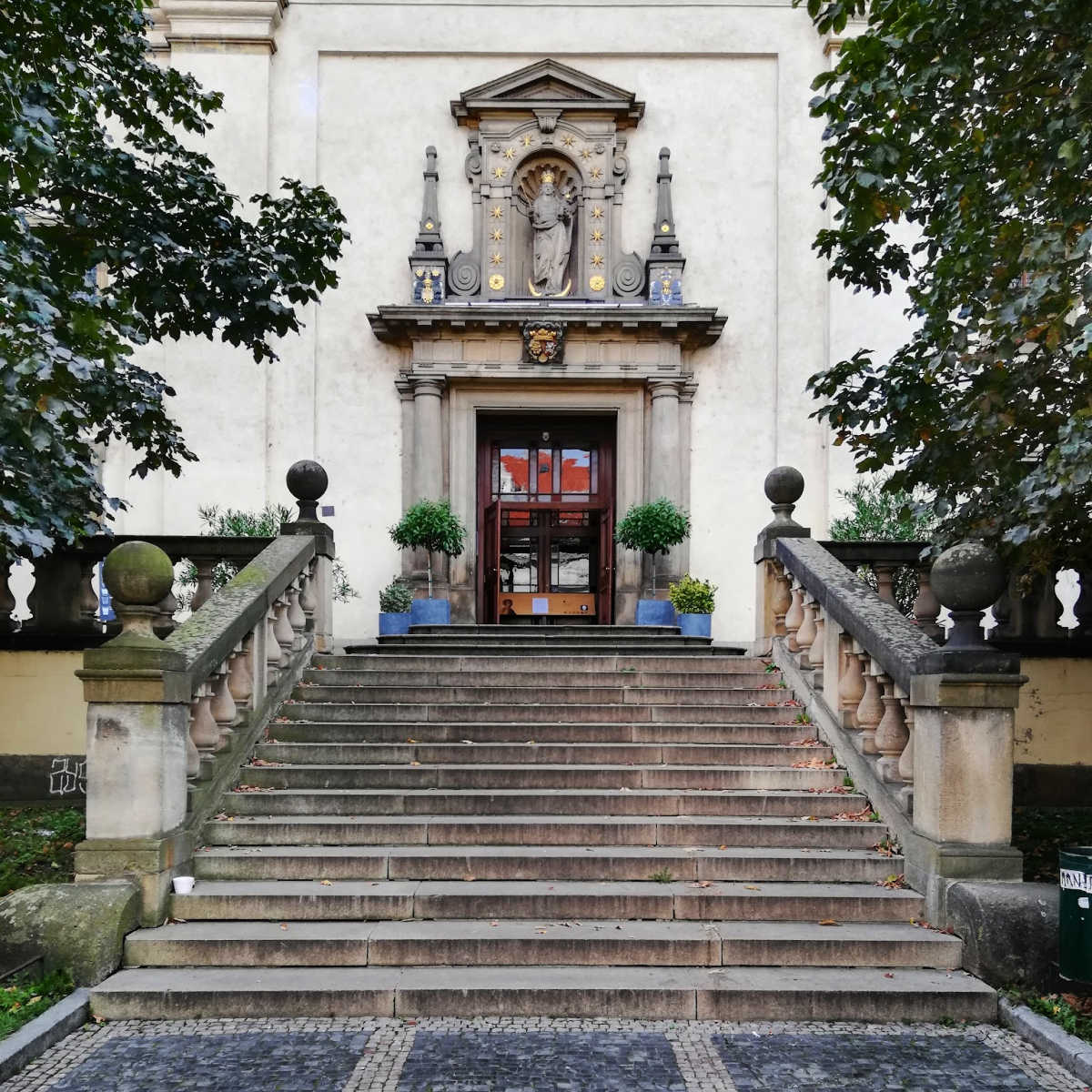
Coffee stop at Church of Our Lady Victorious and The Infant Jesus of Prague
This is an ideal opportunity for another great coffee break, which you can enjoy in the shade of the Church of our Lady Victorious and the Infant Jesus of Prague in Karmelitska Street.
Unlike other coffee places, this one is run by the church itself, so everything you spends contributes towards the running of the church and the coffee itself is really good!
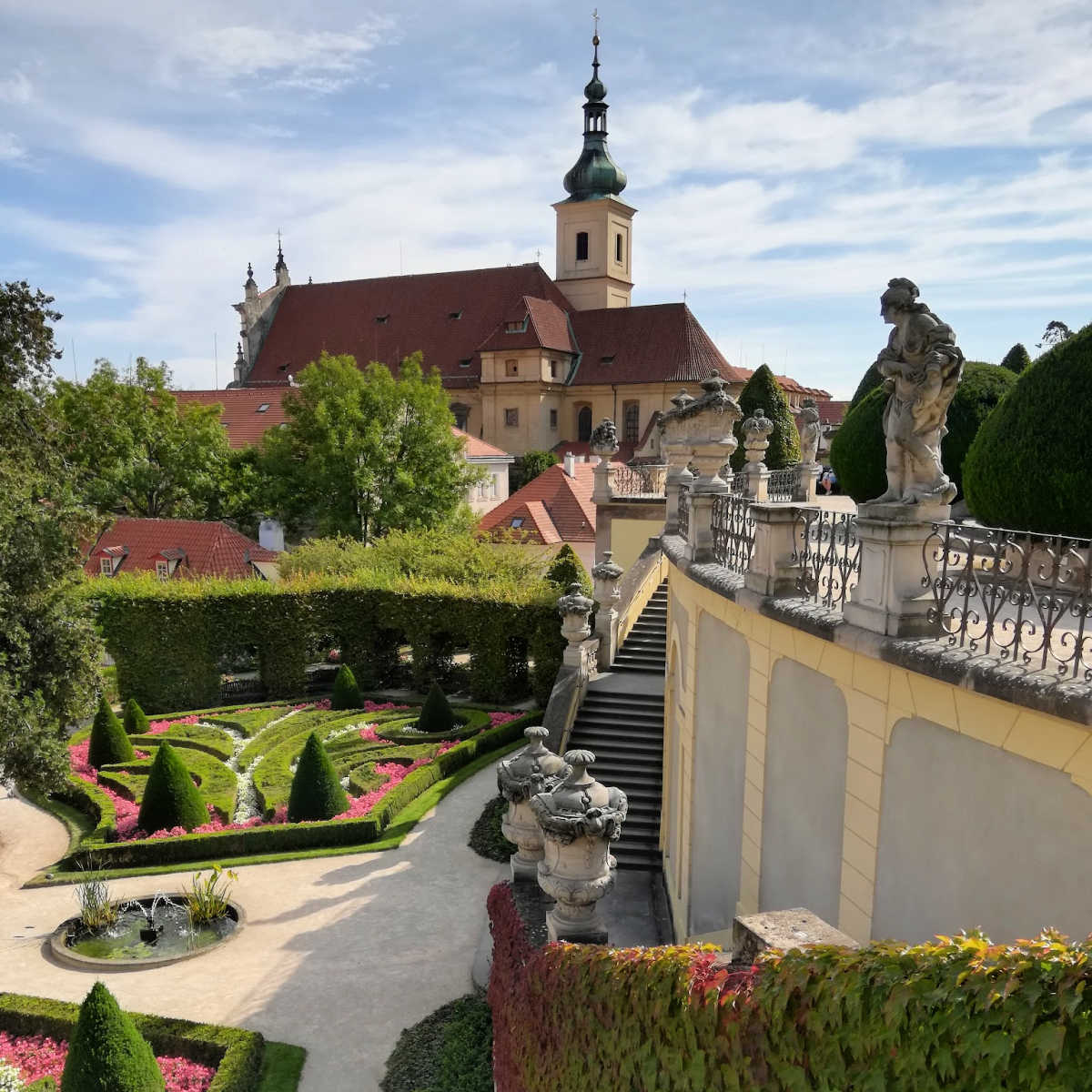
Vrtba Garden – Detour stop – if you have the time – adds at least 60 min to the itinerary
Vrtba Garden is one of the ‘now not so hidden gems of Prague’, but it’s still worth visiting if you have the time.
There are some amazing views of Prague, the castle and of course the garden is very pretty too – laid out on three different levels, with water features, sculptures and beautiful plants and flowers.
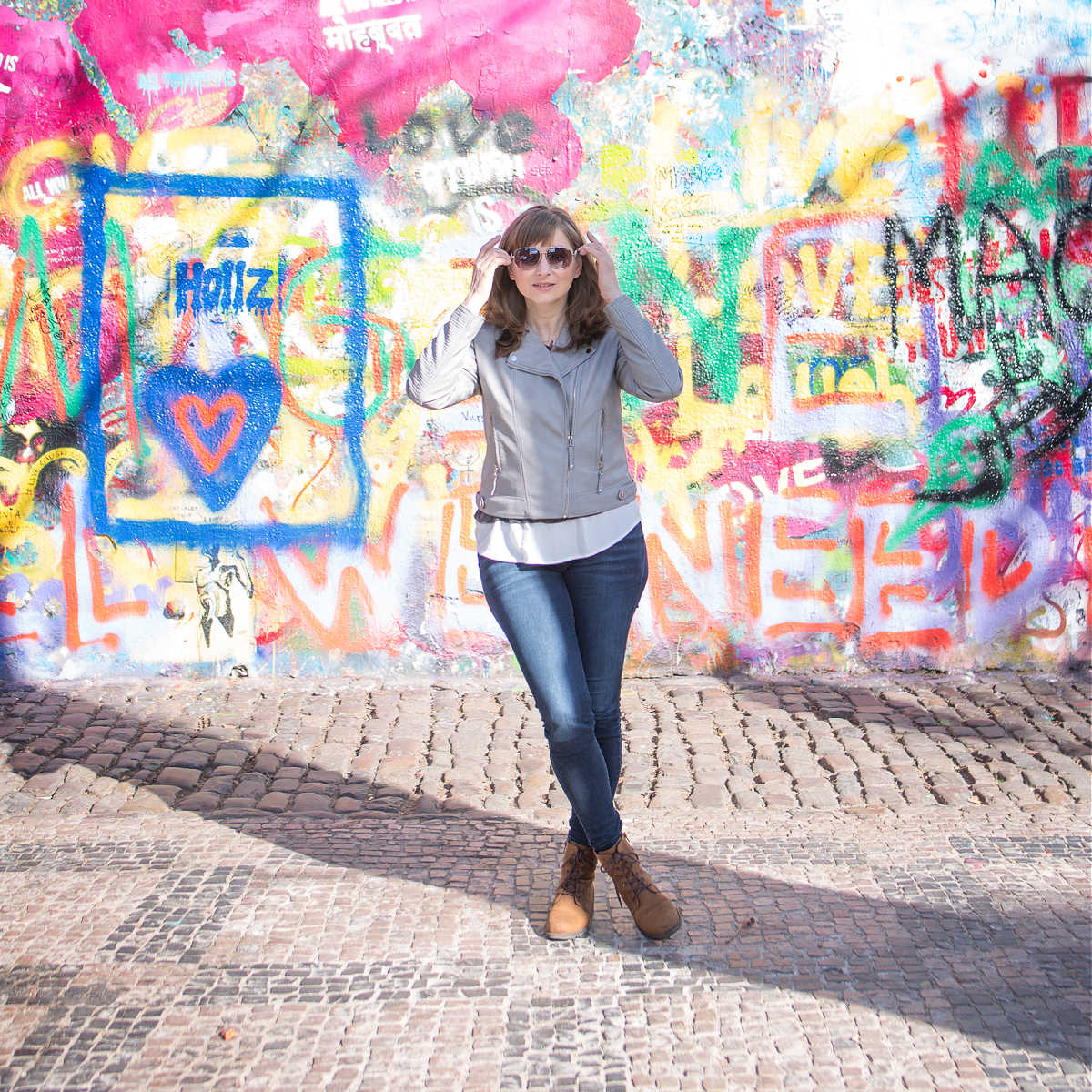
Lennon Wall, Kampa & Certovka Canal
A walk around Prague wouldn’t be complete without a visit to the Lennon Wall just off the Kampa Island. After John Lennon died in 1980 somebody painted his portrait on the wall and after that people started to write their own thoughts, wishes and peace slogans.
This was even more prominent during the autumn of 1989 when the students started the Velvet Revolution and the Czech Republic become a democratic and free country again.
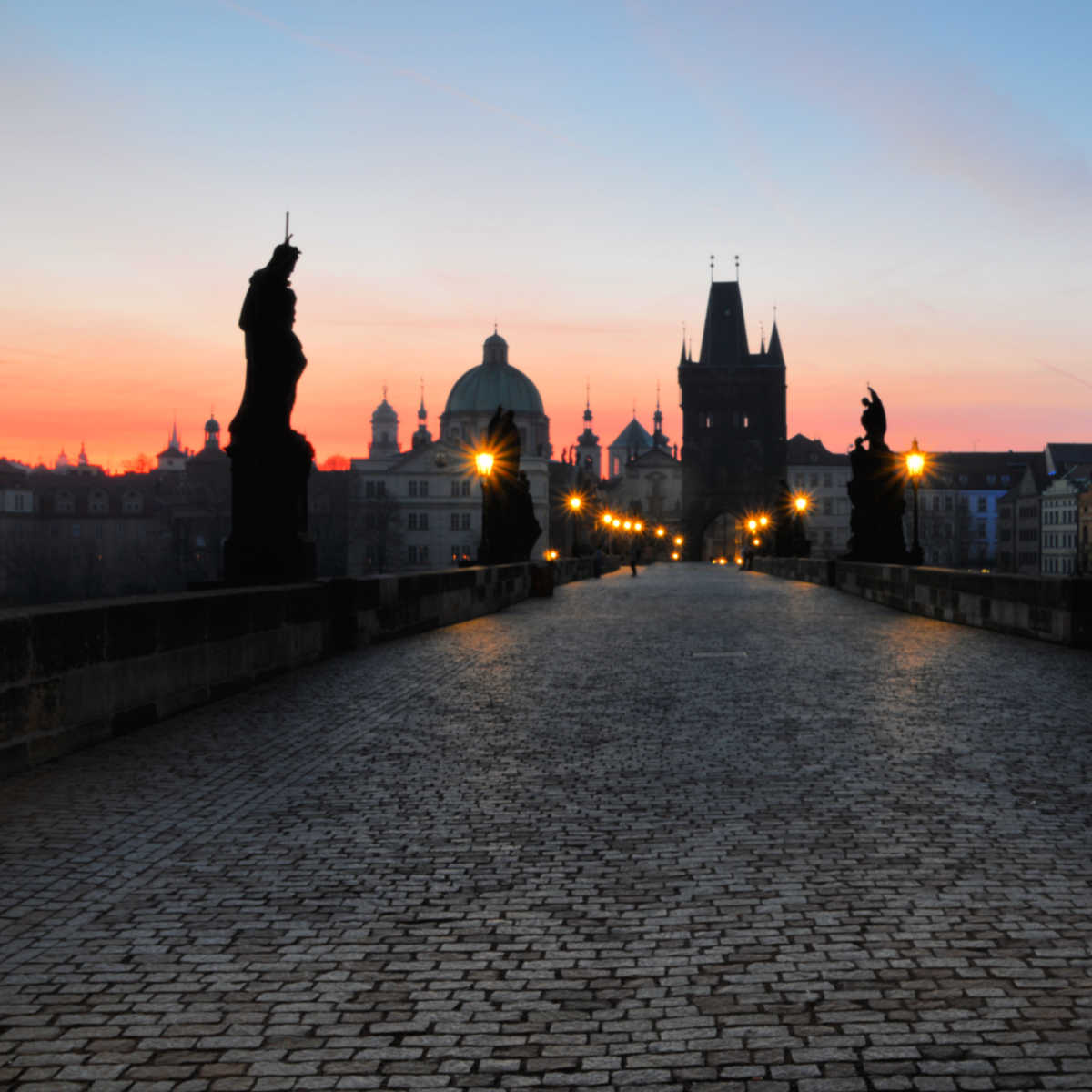
Charles Bridge
We are now approaching the most photographed and famous bridge in Prague – Charles Bridge. If you start today’s walk really early (like 6 am) you might be lucky enough not to have too many people there.
Otherwise, most of the time, Charles Bridge can be quite crowded, but if you find it like this, just enjoy it for what it is – the most amazing historic bridge with many statues and a great views of Prague Castle, the river and other bridges across the river Vltava.
READ MORE

Klementinum Library Complex
When you cross Charles Bridge you have a couple of options – either go straight to follow the Kings route or go slightly to the left through a large door that leads you to a courtyard of a Klimentinum – a university library.
This is my preferred way to the centre as the Kings Route is often very crowded.

Marianske Square
Walk through the Klementinum and keep left as you stroll through the different courtyards. You will arrive at Marianske Square with yet another library and a town hall.
During the Czech state celebrations in May, September, October and November the Town Hall runs open days (for free) when you can join a guided tour of the building and inside rooms.
The Main Town Library often holds open-air exhibitions, concerts and book readings at the square and you can also find a range of small refreshment stalls there.

Fountain with an allegorical statue of the Vltava River (Terezka)
You might also notice a pretty statue of a girl holding a vase. She is called a Terezka and her vase continuously pours water into the well underneath.
The Glam Gallases Palace
The statue is right in front of the Glam Gallases Palace, which is now open to the public after a very lengthy renovation. It belonged to a wealthy family, who had castles and holdings around Liberec before 1948.
The palace was never really opened to the public as the premises were used for archives, so it’s a pretty special building to visit.
You can walk for free through the palace courtyard, but to see the inside you need to buy a ticket for an exhibition. There are usually art or cultural exhibitions organized by the Prague National Gallery.
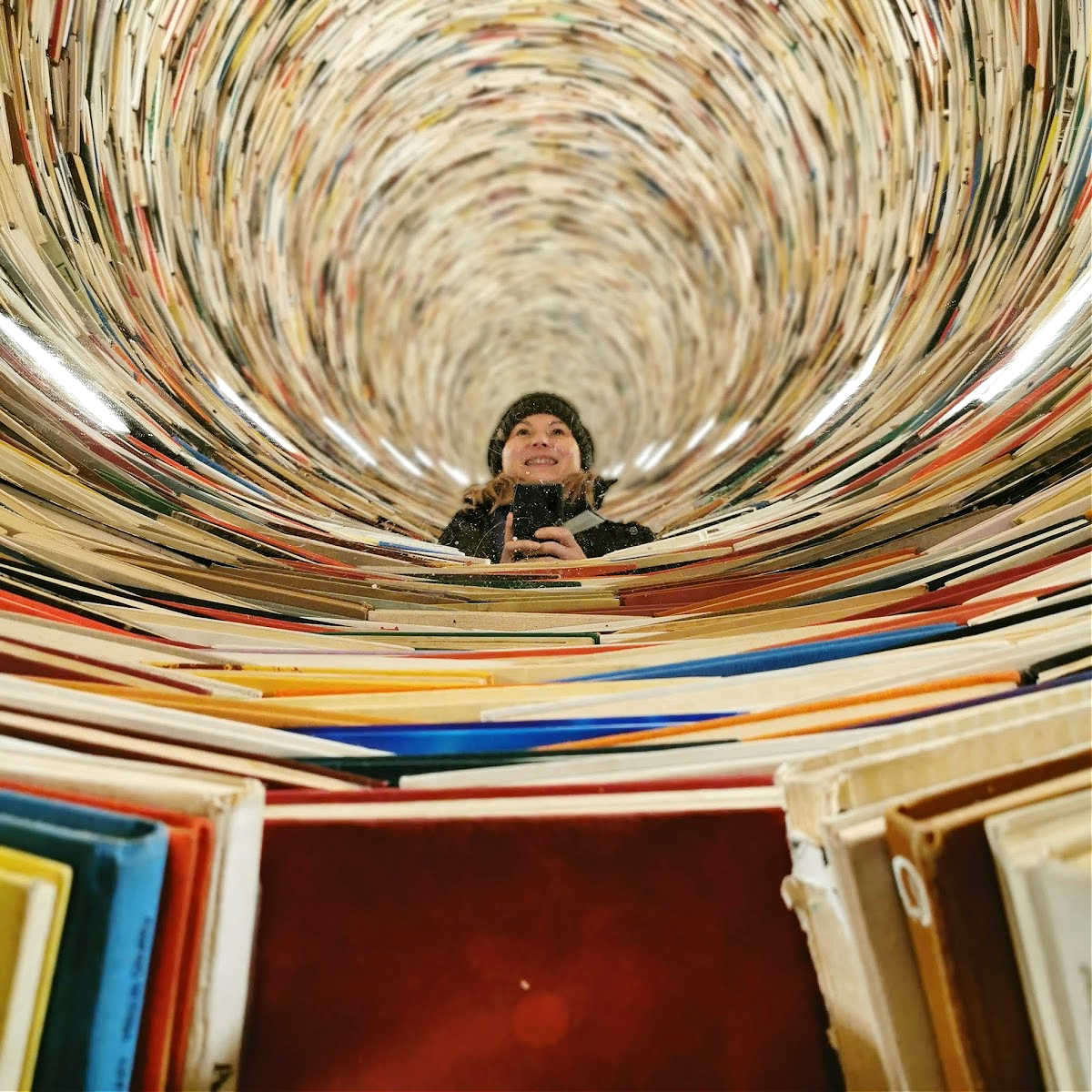
Coffee break & The book installation at the Municipal Library of Prague
The Town Main Library has a coffee place inside which has a good selection of freshly prepared sandwiches, homemade cakes, and decent coffee at reasonable prices.
Also, pop in to the main entrance of the library to have a look at an art installation made from books. The installation is called Idiom and it’s been designed by the artist Matej Kren in 1998 and it’s made from over 8000 books.

Lunch at the Restaurant in the Museum of Decorative Arts in Prague
If you have a bit more time, you can also walk towards the Museum of Decorative Arts. The cafe there serves simple but tasty lunches, salads and has homemade cakes and pretty amazing coffee.
If you have the time (or fancy a little diversion) the Museum of Decorative Arts has always interesting exhibitions on. Last time I’ve visited exhibition of 19 century advertisement leaflets which showed the way marketing worked at the end of 19 and beginning of 20 century.
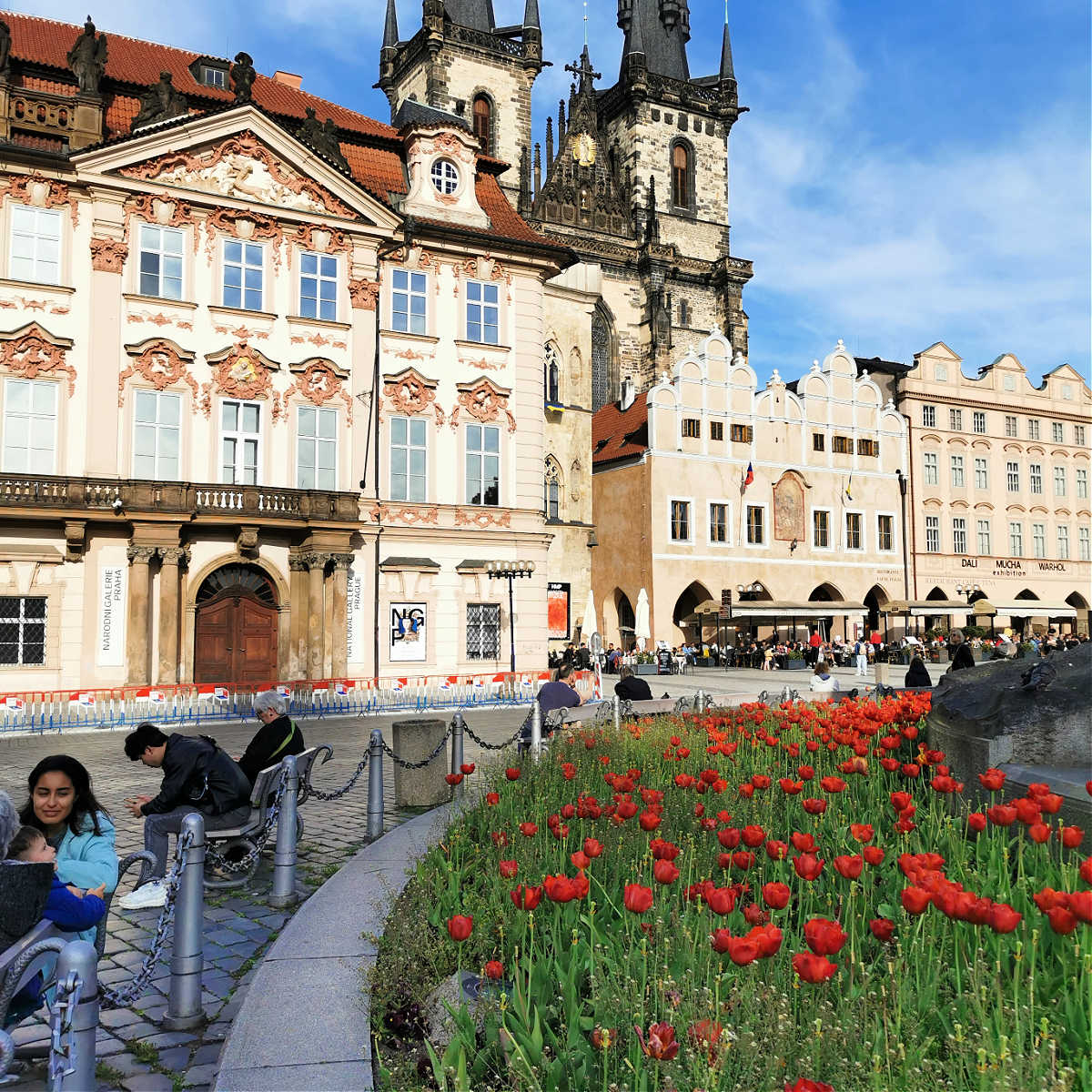
Walk around the Old Town Square
Returning back to our Prague walk, you’ll now find yourself at the Old Town Square with it’s moving clock, stalls selling souvenirs and many restaurants. If you time your arrival just before the whole hour, you can watch the clock striking and the moving statues of saints going around inside the clock windows.
The Old Town Square in Prague is one of the most beautiful squares in Europe. It is the oldest and most significant square in historic Prague and has been a bustling marketplace at the intersection of European trade routes since ancient times.
Nearby stood the customs house (Ungelt), where goods imported by foreign merchants were taxed. In 1338, King John of Luxembourg granted the Old Town permission to build its own town hall. The inspiration for the town hall was the Gothic house of the wealthy merchant Wolflin from Kamene and tall tower was added in 1364. The famous Old Town Astronomical Clock with moving figures of the apostles was made in 1410 by master Nicholas of Kadan.

Next to the Old Town Hall and the Church of Our Lady before Tyn, the dominant feature of the square is the Baroque Church of St. Nicholas by architect K.I. Dienzenhofer, the Rococo Palace of the Kinsky family, which now houses the Graphic Collection of the National Gallery, the House at the Stone Bell – a Gothic city palace from the 14th century, now a concert and exhibition space of the Gallery of the Capital City of Prague, and the Jan Hus Memorial from 1915 by Ladislav Šaloun.
The location of the execution of 27 Czech lords (June 21, 1621) and the Prague Meridian are marked on the square’s pavement. You can also see the newly added collum of St Mary, which was originally stud here until 1918 when it was demolished by a drunken crowd in a political protest.
Originally, the square was called Great Square, in the 13th century, the name was changed to Old Market. In the 14th century, the square was referred to as the Old Town Market, and the current name (Old Town Square or Staromestske Namesti) dates back to 1895.
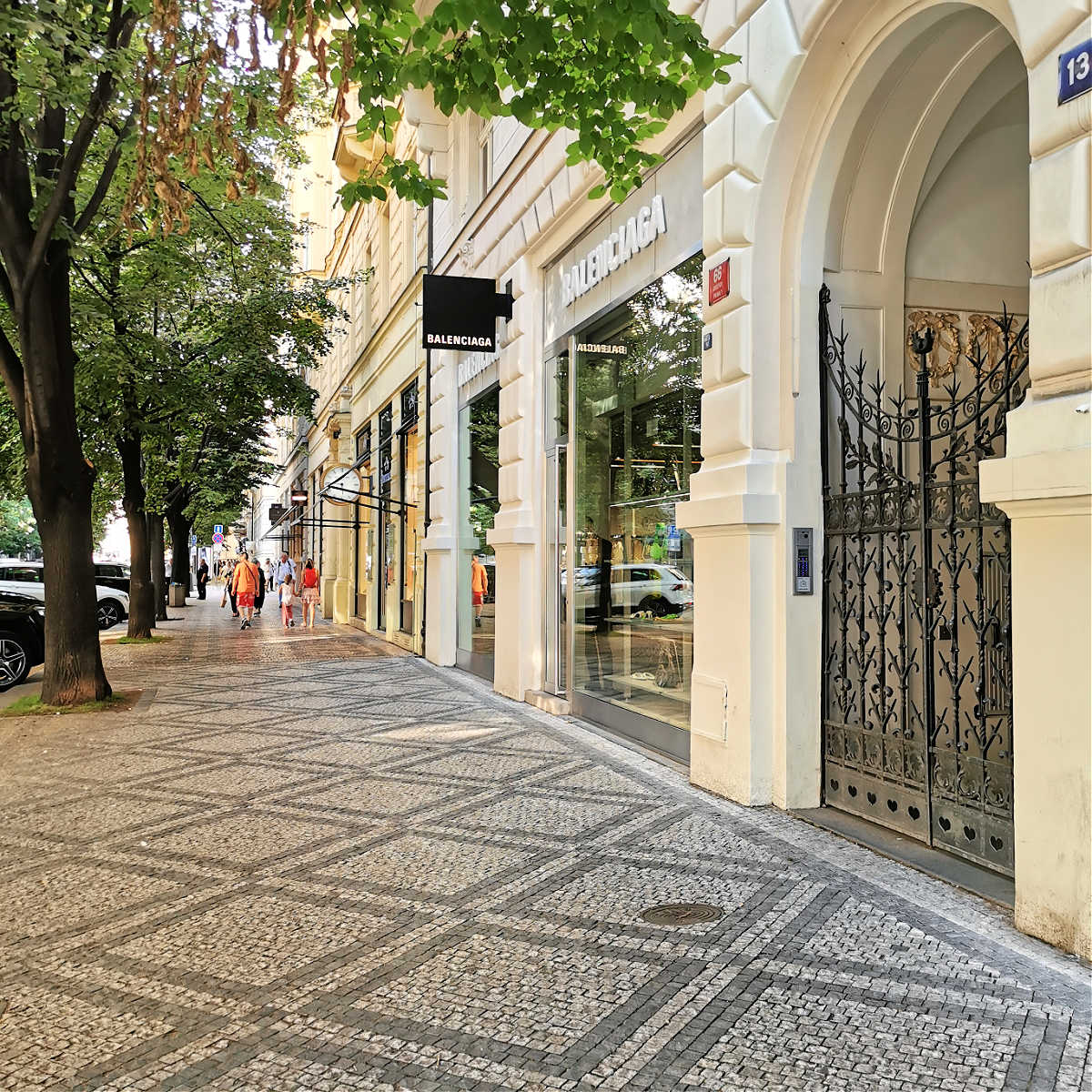
Stroll by the luxury shops in Parizska Street
Pařížská Street, just off the Old Town Square, is a road full of luxury shops, lined with buildings featuring impressive facades, where you can enjoy a pleasant stroll and of course, enjoy window shopping (or a real shopping if you have the budget!).
Walking down the Parizska street, you really feel the atmosphere of the French capital – Paris, which is how the street got it’s name. Old buildings with large glass shop windows showcase the most exquisite products of the most expensive clothing, jewellery, and fashion accessories. You can find here luxury brands, such as Hermés, Dolce & Gabbana, Louis Vuitton, Prada, Gucci, Jimmy Choo, Fendi, and many others.
The 500-meter-long Pařížská Street connects Cechův Bridge with Old Town Square and because of the town redevelopment at the end of the 19th and beginning of the 20th century, it runs through the center of the former Jewish Quarter.
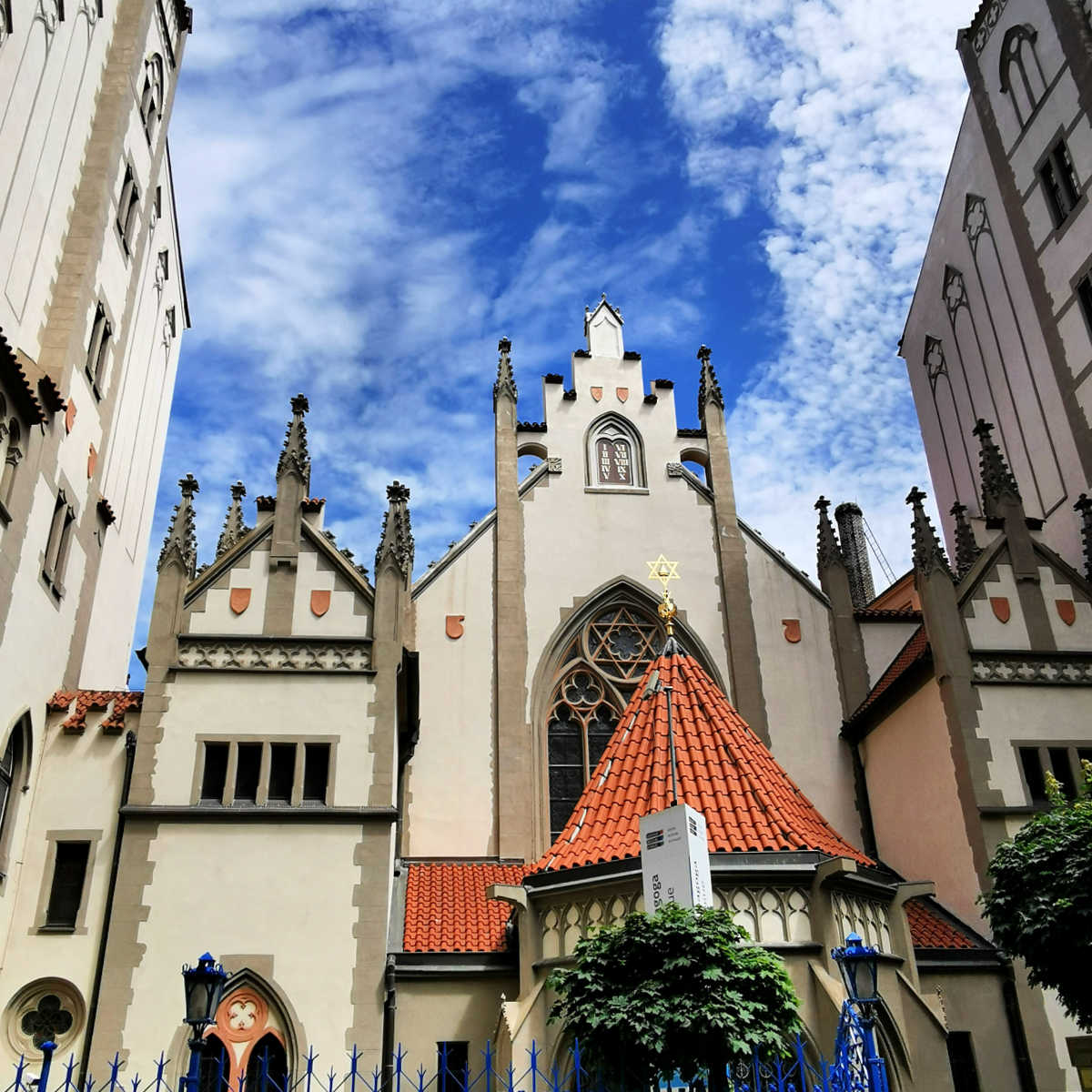
Pause for a thought in the Jewish Quarter – Josefov
The Josefov district is the smallest official district area in Prague and until 1850 it was called the Jewish Quarter, and before that, it was known as the Jewish Ghetto. Today, it is a preserved complex of significant Jewish monuments of European importance.
The original Jewish Ghetto was condemned to “sanitation” at the end of the 1880s labelled as a poor district. Only a few buildings survived from the original ghetto, including the Jewish Town Hall, the Old Jewish Cemetery, and six synagogues: Klaus, Maisel, Pinkas, Old-New, Spanish, and High Synagogue.
During World War II, Jews were deported to concentration camps. The abandoned Josefov became a warehouse for confiscated property. After the war, much of the legacy remained in the hands of the Jewish Museum because its original owners didn’t come back from the concentration camps, and because of that the Jewish Museum became the second-largest Jewish museum in the world.
Although only a few of the most important monuments and buildings from the centuries-long history of Prague’s Jews have been preserved, they form the most preserved complex of Jewish monuments in Europe.
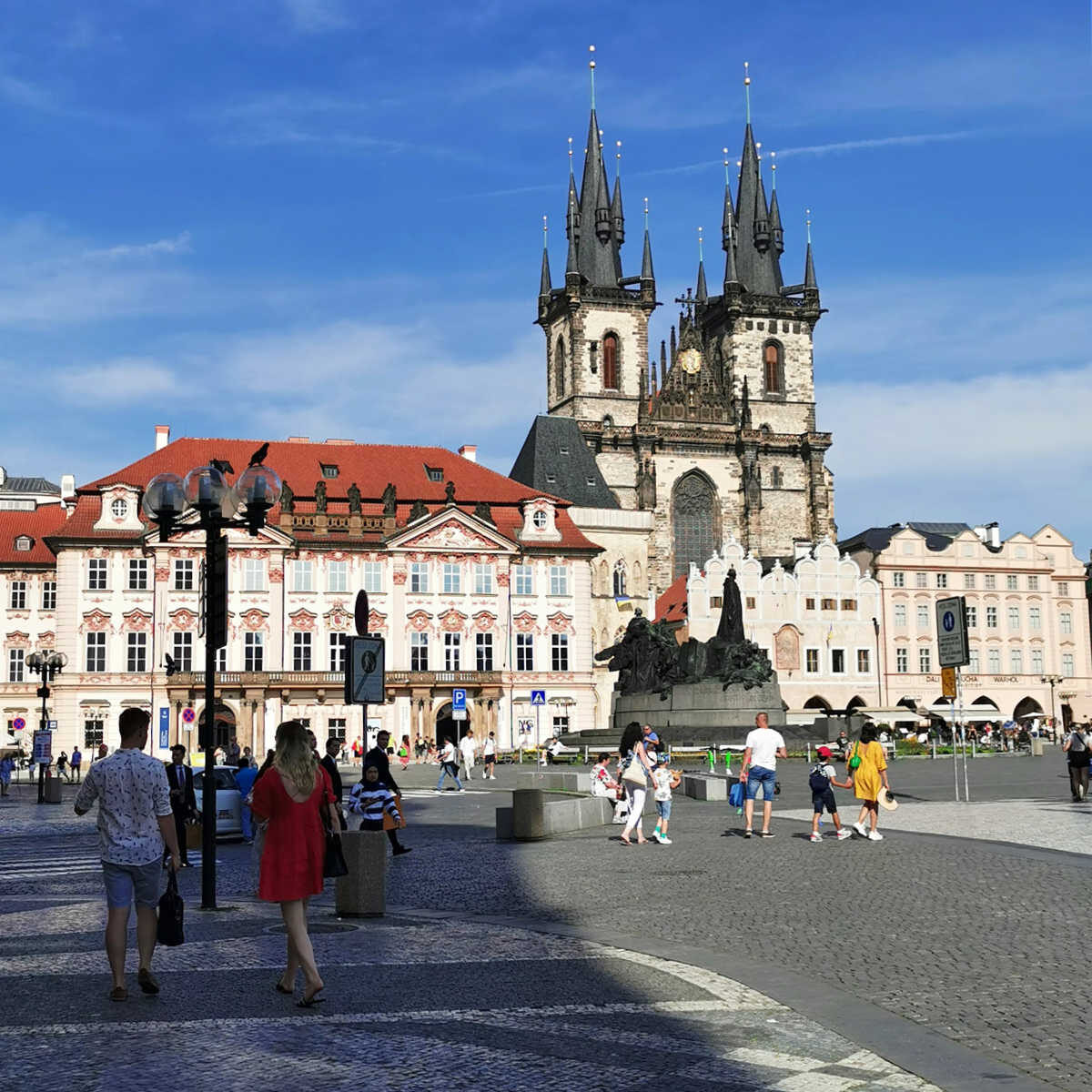
Visit the Oldfashioned Tyn Square
Return back from the Jewish quarter via Parizska Street or any of the side streets back to the Old Town Square. From the Old Town Square, walk through the tiny street called Tynska to get to Tyn and Ungelt Square.
It’s a perfect example of what the centre of Prague looked like in olden times with its unique mix of small decorative dwellings right next to imposing Baroque buildings all the time surrounded by attractive archways and glistening cobblestones. You’ll find plenty of restaurants, shops and galleries there.
If you have the time you can explore this area further. Just round the corner you’ll find the famous Powder Tower where you can view the whole centre and the castle from the top of the tower.
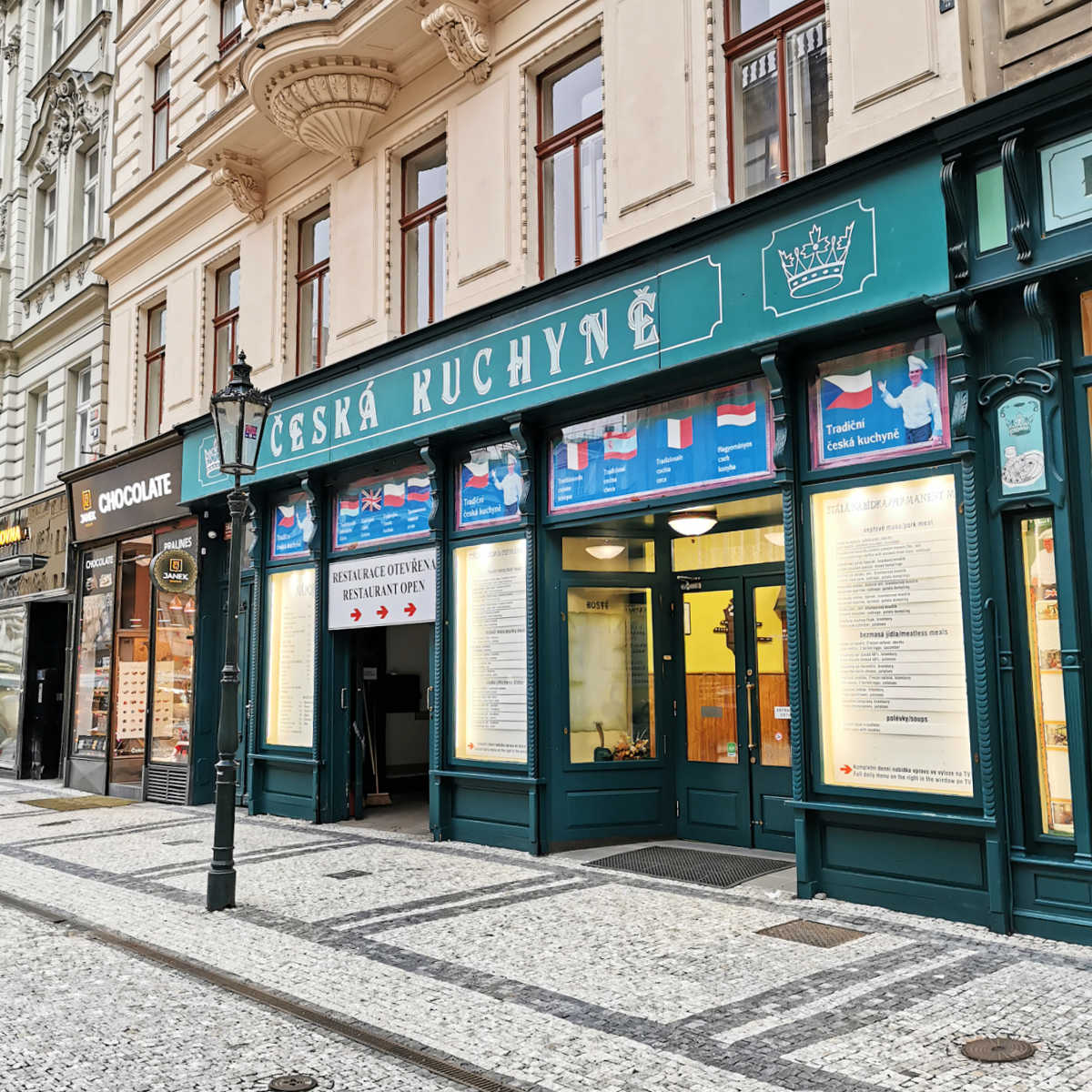
Dinner stop at Ceska Kuchyne
This is totally one of my favourite places to eat in central Prague. Non-pretentious, easy going, simple but tasty traditional Czech food served without waiting and at a great price too!
If you’ve come to Prague to eat gourmet food at 5-star hotels, this is not a place for you!
But if you are hungry, want to eat right away without waiting or perhaps would feel awkward in a high-end restaurant (that’s me, by the way!) and want to try traditional canteen-style food, please come in!
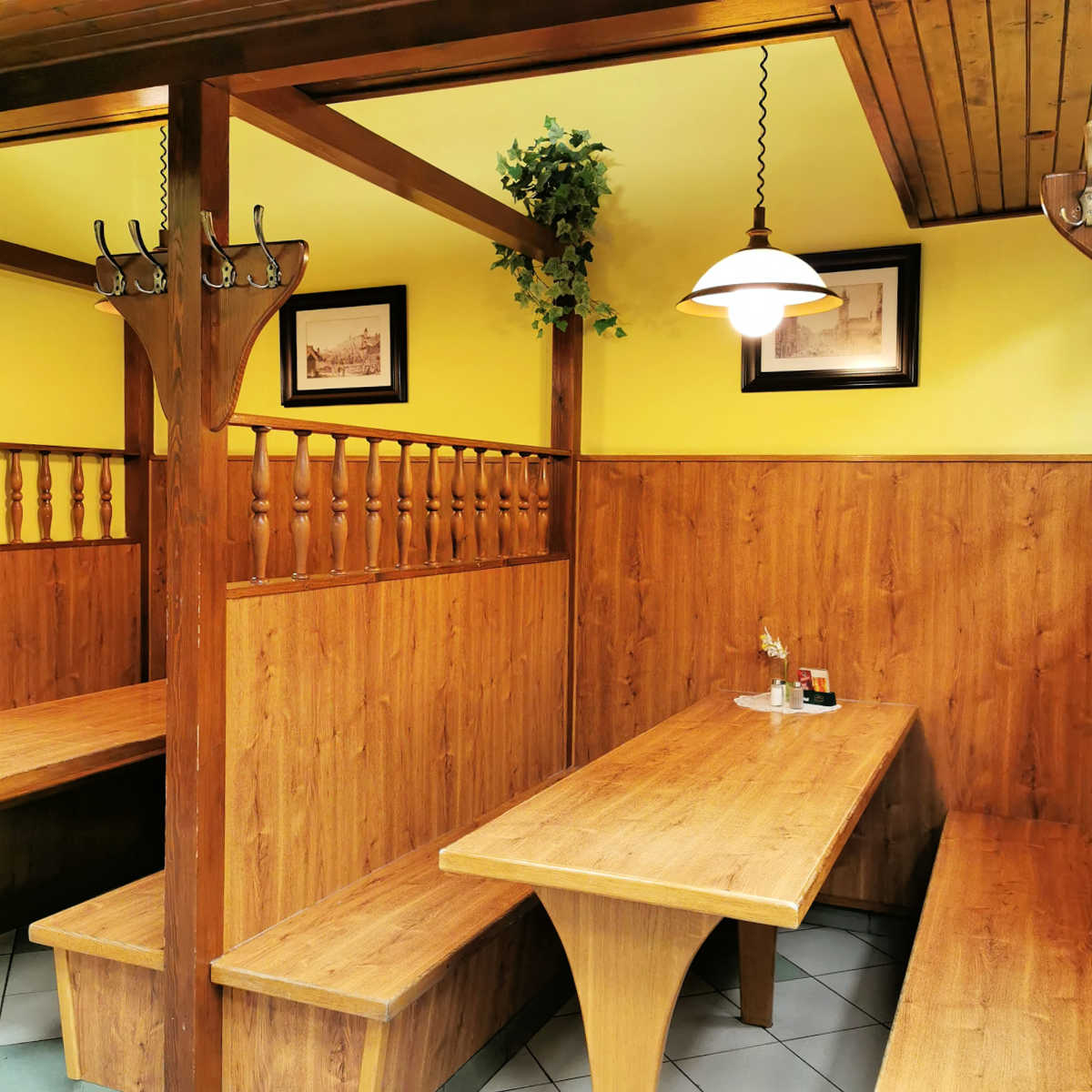
I should mention, that there is a certain way this restaurant works. As you enter the restaurant you’ll be given a white ticket. Next head over to the food areas.
The starters and puddings/sweets/hot drinks are at the front and the mains and cold drinks at the back of the restaurant on the left handside. Try a beer or ‘pivo’ and you’ll be charged a fraction of the price you’d pay at a nearby restaurant.
Pick up a tray and wait your turn and point or say whatever you fancy eating. At the same time, give the lady at each counter your ticket and she will write a short code for the meal you’ve just requested.
The short-codes are not the prices and you’ll see special codes for individual portions and elements of the food (like dumplings, bread, cucumber, extra potatoes etc.) Don’t be alarmed if it looks like a long list and you’ve only ordered one plate!
The prices are written on the board and for mains you’ll want the meat element (for example ‘gulash’) and the side dish (for example ‘knedliky’ dumplings). You can pick and choose whatever you like, if you don’t want dumplings with your gulash you can have just bread or nothing, it’s your choice.
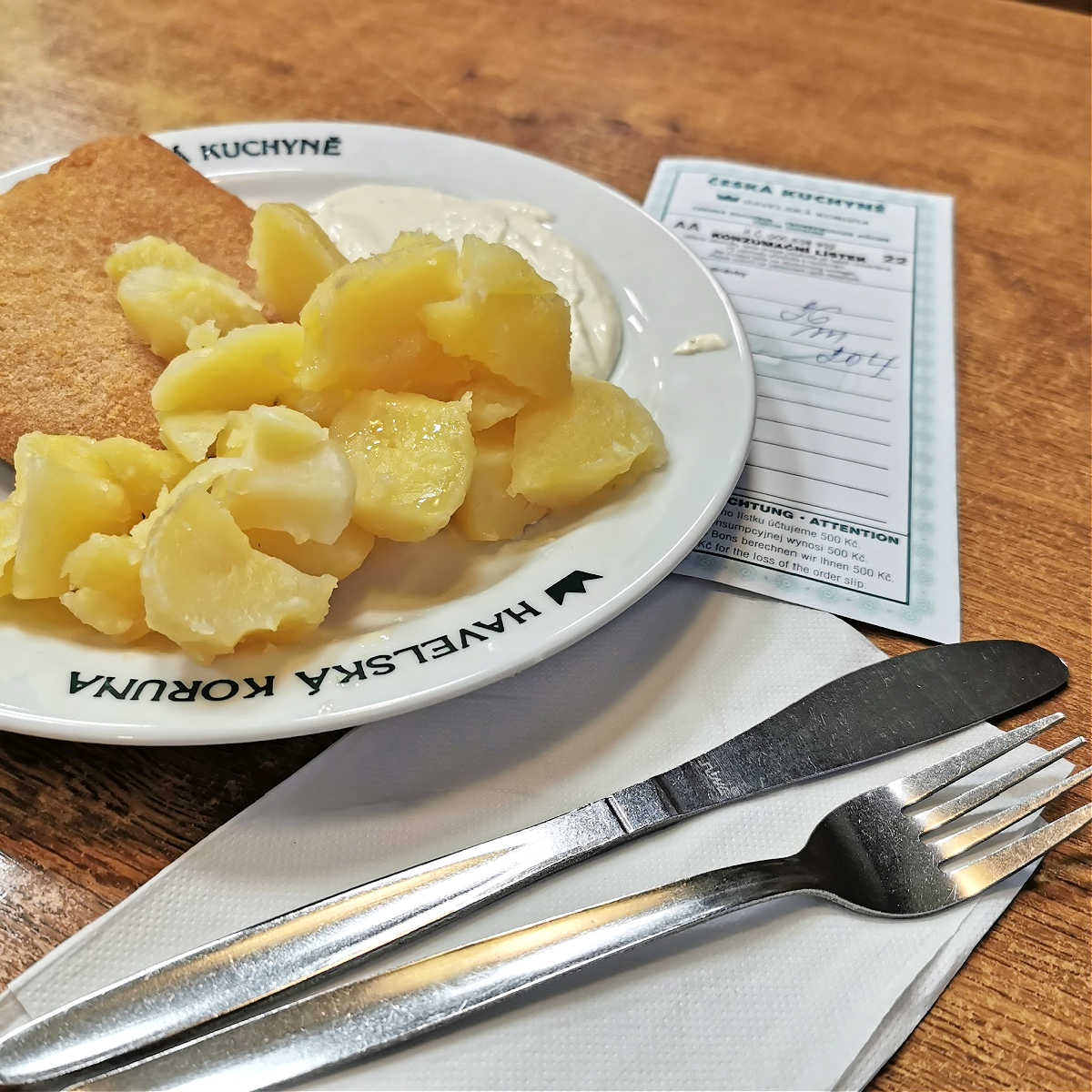
After you select your meal, it will get plated up for you straight away and you can choose where you want to sit. There are usually plenty of spaces and there is even a little conservatory with wicker chairs.
If at any point you want more food or want a pudding or coffee, just take your white ticket to the other counter and pick what you like.
The restaurant staff asks that you take your empty trays and dishes to a designated area in the middle of the restaurant.
When you are ready to leave, simply hand over your white ticket to the checkout lady and she will total everything up for you.
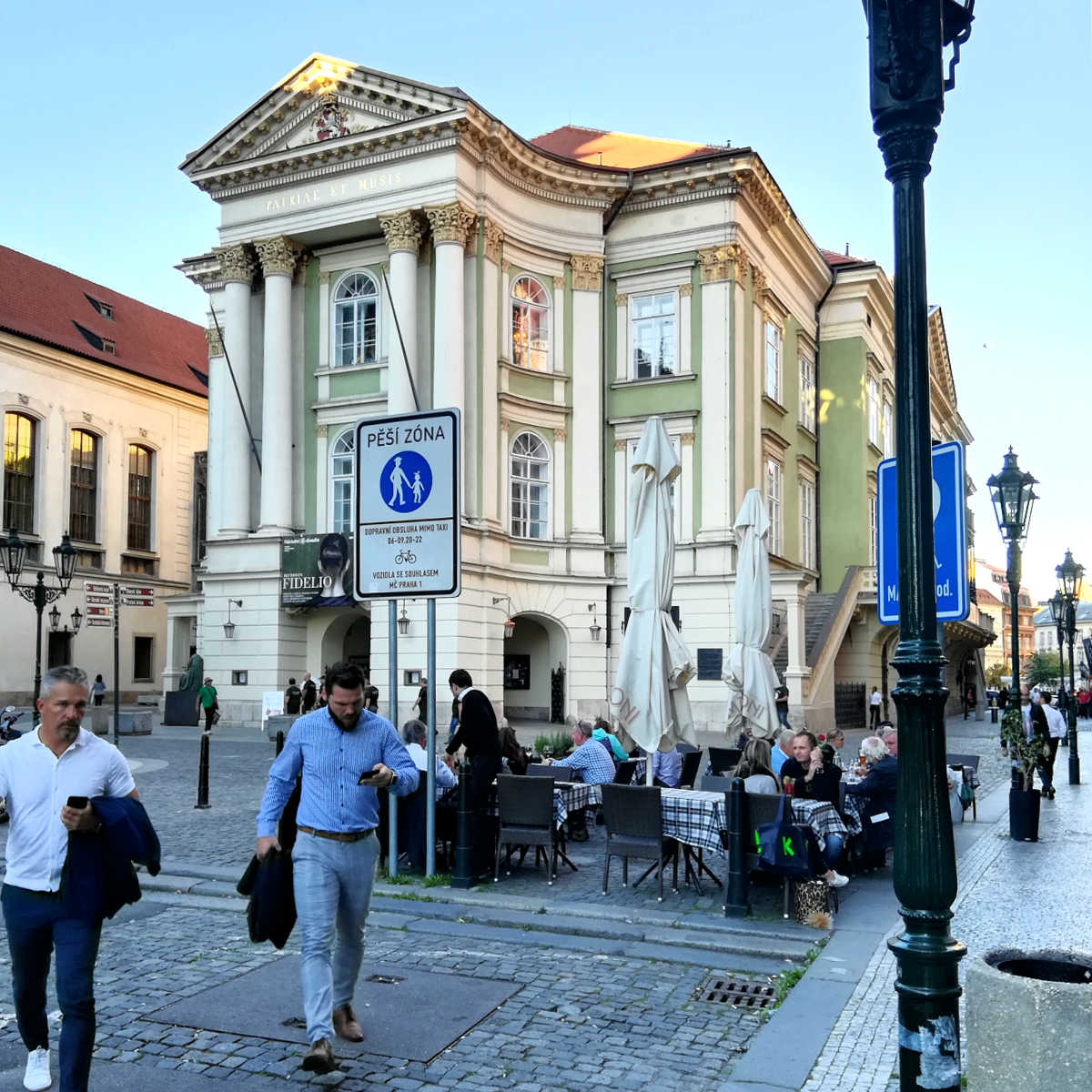
The Estates Theatre
Before you start heading up to the Wenceslas Square, walk a little sideways to Ovocny Trh (Fruit Market) on the same street as Ceska Kuchyne and you will see the Estates Theatre the oldest theatre still in use in Czech Republic and the whole Europe.
Mozart has performed here many times and even composed an opera for Prague people since he liked it here so much.
If you fancy going to the theatre in the evening, check out the list of theatre plays that are displayed at the theatre entrance. A lot of these now include English subtitles, especially if it’s an opera. Tickets are sold in the building opposite the theatre or you can book online.
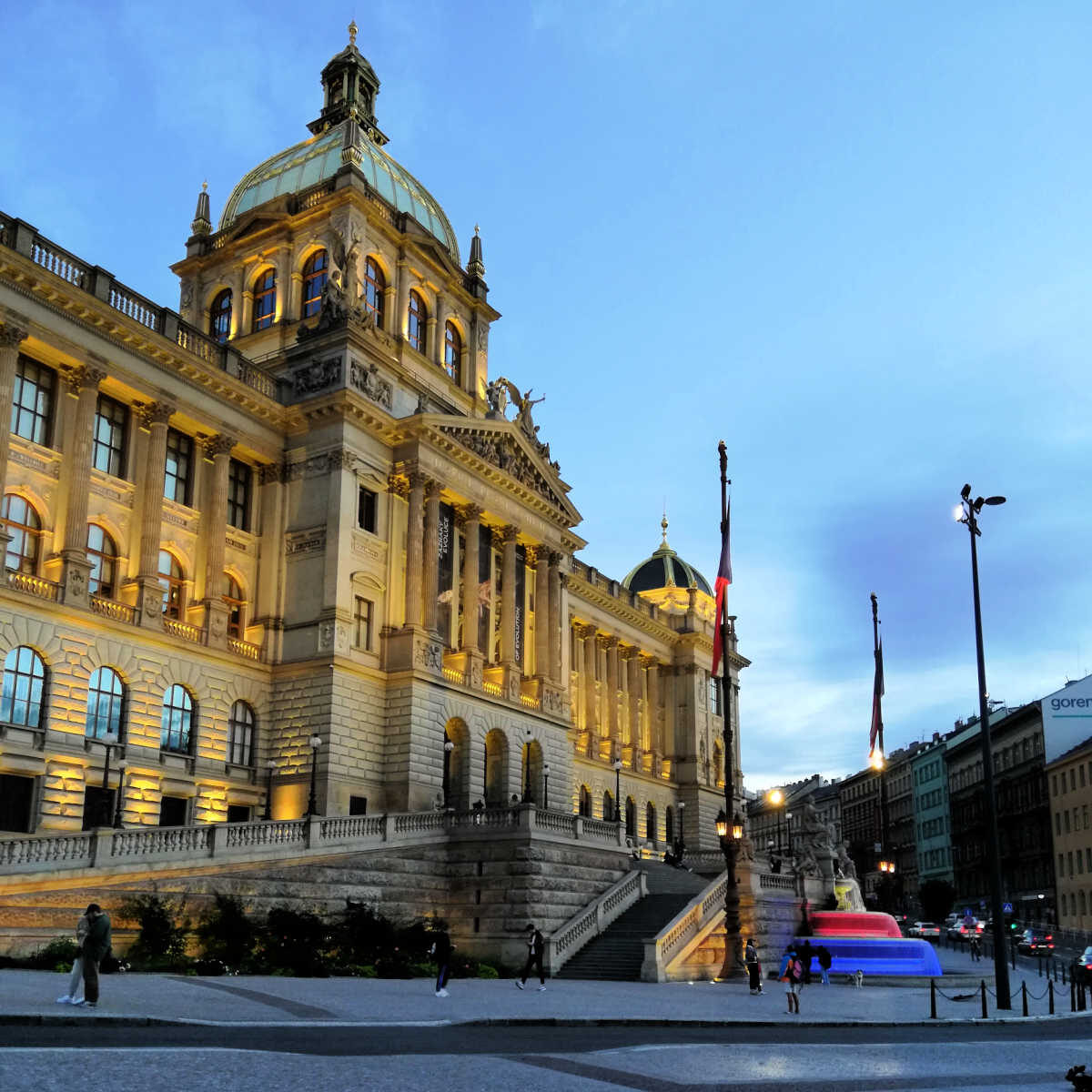
Wenceslas Square ( Vaclavske Namesti)
As you walk up the Wenceslas Square, you’ll be surrounded by some amazing architecture, shops and restaurants. I usually walk up half way to the Svetozor Passage for one of best ice creams in Prague, traditional cakes (try the ‘Spicka’ or Vetrnik’ and to catch up on the latest art film!
Svetozor shows regular films, but also art films and Czech films with English subtitles. The cinema has 3 screens and there is always something interesting to watch.
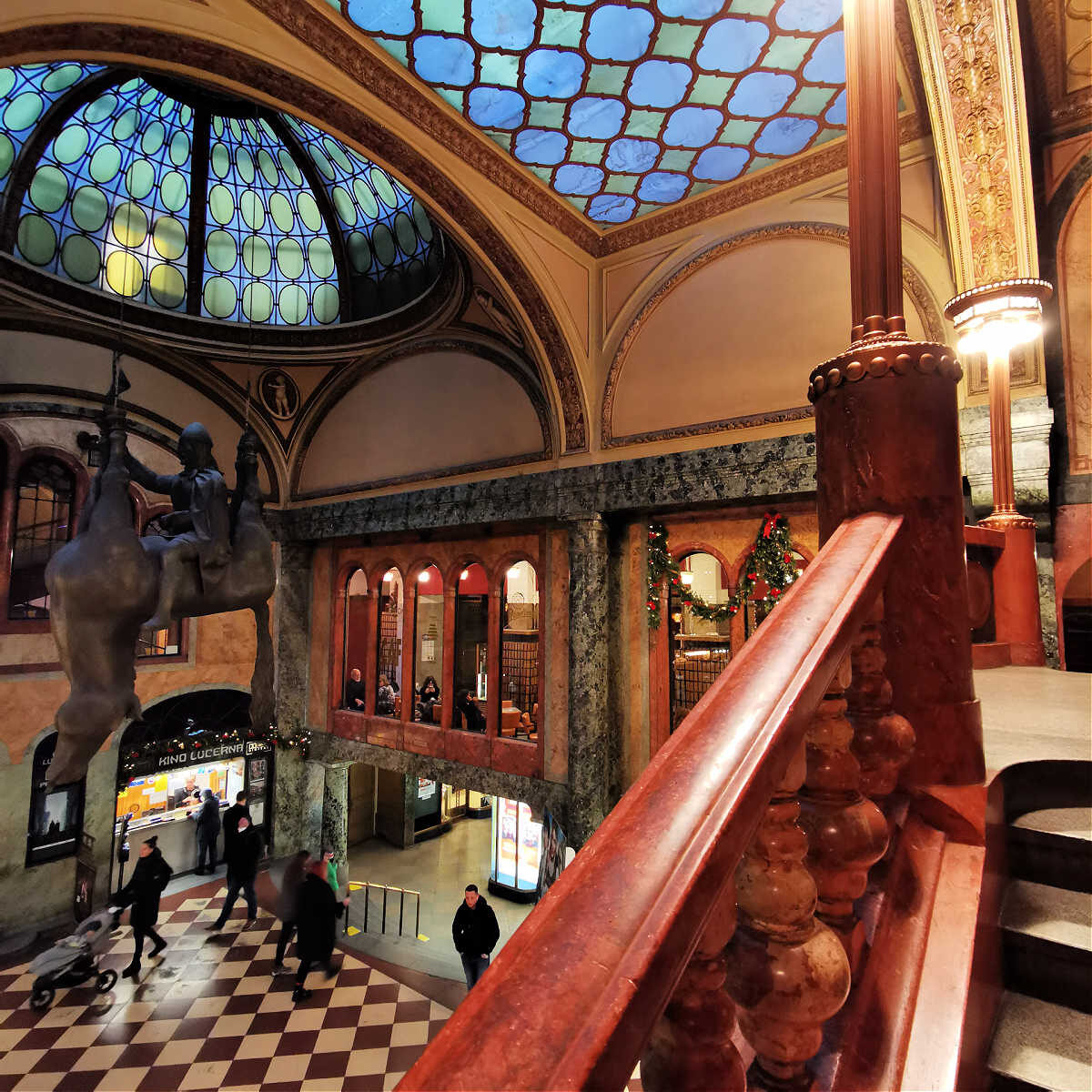
Lucerna Passage
If you can’t find something you like there, walk across the street to the Lucerna gallery where you’ll find not only another old-fashioned cinema, but also an old fashioned coffee house, a David Cerny sculpture of a horse hanging upside down (oh, yes, that one!) and in the summer you can visit the Lucerna roof terraces.
If your legs can still carry you (or after you had a good cake, coffee and watched some nice film) walk up to the top of Wenceslas Square where you’ll see the main National ‘Narodni’ Museum which is illuminated in the evenings. The fountain in front of the museum is also lit up in white, blue and red, which symbolise the colours of the Czech flag.
From the top of Wenceslas Square is only 10 minutes to the Main Train Station or Museum Underground Station entrance (Lines A, C) is right next to the statue of St Wenceslas.
I have more suggestions on what to do in Prague in the evenings on my blog, so make sure you check it out.
PIN THIS GUIDE FOR LATER

This blog post was originally written on 3 November 2021 and last updated on 1 June 2023